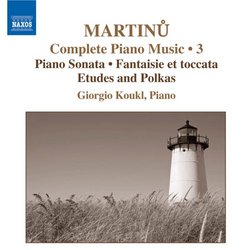Two of Martinu's Best Piano Works, and More
J Scott Morrison | Middlebury VT, USA | 09/24/2007
(5 out of 5 stars)
"Martinu is not particularly noted for his piano music, but he wrote a lot of it. This is the third in a series of what appears to be a complete traversal of his piano pieces by Swiss-Czech pianist Giorgio Koukl. Best of all, this volume contains two of Martinu's best and best-known piano pieces, his Fantasy and Toccata from 1940 (written as he was in Aix-en-Provence awaiting a visa that would get him out of occupied France, where he'd lived for many years) and the single Sonata from 1954. Also included are three volumes of Etudes and Polkas and Three Czech Dances, miniatures all.
Martinu's style changed over the years, at least in its externals, but he had achieved his characteristic voice by the late 1920s. Among his music's identifying features are some harmonic progressions that often used the so-called Moravian cadence (similar to the plagal 'Amen' cadence), use of second-inversion chords whose bass note is used as if it were a tonic note, and harmonies based on thirds and sixths. Additionally there is strong tonal underpinning often spiced with dissonances. His music is strongly influenced by such disparate predecessors as Stravinsky and Debussy. All these characteristics are in evidence in the pieces present on this disc.
The Fantasy and Toccata, lasting about seventeen minutes, is one of Martinu's longest piano works. He dedicated it to the eminent Czech pianist, Rudolf Firkusný, who was also in Aix-en-Provence awaiting a ship to the US. (Indeed, it was Firkusný who had phoned Martinu to warn him of the imminent invasion of France by the Nazis, a call which led to the Martinus immediately leaving Paris and ultimately France.) Its two sections are rather darker than most of Martinu's piano music up to that time and there is a sense of drama, even doom, inhering to its opening moments. Although there is no program attached to the work, one cannot but feel that the unsettled, even frightening, situation for the Martinus is a part of what went into its composition. One can even imagine a 'fleeing' motif in the Toccata.
The Sonata was written in Nice, while the Martinus were back in Europe for the first time after the War. It is Martinu's longest piano work and was dedicated to his dear friend, Rudolf Serkin. It was premiered in 1957 in Brno by Eliska Nováková and played in recital the very next day in New York by Serkin, who continued programming it for years, often in conjunction with Beethoven's 'Hammerklavier' Sonata. In three movements, in it one senses more contentment, even whimsy, as contrasted to the Fantasy and Toccata. There are some endearingly naïve harmonies that could be thought to reflect a kind of Coplandesque American sound. Consistently more triadic than the Fantasy, the Sonata is nonetheless a very sophisticated work whose form involves a complex interweaving of themes and gestures among the three movements.
The three volumes of Etudes and Polkas -- sixteen pieces in all -- are consistently lighter and shorter than anything prior on this disc. They were written in the space of month in July-August 1945, just after the end of the War, while Martinu was living in Cape Cod. These pieces are Bohemian to the core, in both their Czech rhythms and their use of (invented) folk melodies. (Booklet notewriter Mark Gresham makes clear the not widely known fact that the term 'polka' does not have any relationship to Poland, as is often supposed, but comes from a Czech word that means 'one-half', referring to the characteristic 2/4 time signature of the polka.) These are invigorating and entirely delightful pieces. The CD ends with the 1926 Three Czech Dances (not to be confused with an entirely different and better-known 1949 two-piano set with the same name). They are from much earlier than the other music on the disc and are more indebted to Stravinsky than anything else here. Somehow Martinu manages to combine the heavily accented regular Czech dance forms (including another polka) with the apocopes of Stravinskyan rhythm. A real find.
This is, for me, the best of the three volumes of Martinu piano music so far in this series. Koukl clearly has this music in his fingers and heart. I had never heard either the Fantasy and Toccata or the Sonata before and am glad to have become acquainted with them. And I can't quite get the rhythm of the Obkrocák, from the Three Czech Dances, out of my head -- in my mind, a good sign!
Recommended.
Scott Morrison"

